Understanding the differences between MarTech vs AdTech is crucial for startups and software developers in today's digital landscape. The dynamic realm of digital advertising and marketing technology presents numerous challenges and opportunities that can significantly impact a business's success. By delving into the distinctions between these two domains, startups and developers can effectively tailor their strategies and solutions to achieve optimal results.
Aloa, an expert in software outsourcing, plays a pivotal role in helping businesses and startups navigate the challenges MarTech and AdTech present. Our expertise in social media management tools, adtech platforms, and data management platforms ensures businesses can effectively manage customer relationships, harness customer behavior insights, and streamline advertising campaigns across different functions.
In this blog, we’ll delve into the distinctions between MarTech vs AdTech, providing examples of adtech solutions and showcasing their role in ad placement, inventory, and content. Afterward, you will understand how MarTech and AdTech operate, enabling you to make informed decisions to enhance your marketing operations, optimize ad campaigns, and achieve better ROI in the competitive digital landscape.
Let's get started!
MarTech vs AdTech: What’s the Difference?
Understanding the distinctions between MarTech vs AdTech is crucial for startups and software developers navigating this ever-evolving landscape. MarTech and AdTech are technologies that serve different purposes in the marketing ecosystem. Let's explore the five key differences between these two domains.

Focus and Function
Understanding the focus and function of MarTech and AdTech is crucial. Let’s explore the distinct purposes and roles of MarTech and AdTech in marketing, helping you grasp the nuances of their focus and function.
- MarTech: Marketing Technology primarily revolves around tools and platforms that enhance the marketing strategy. It encompasses email marketing, Content Management Systems (CMS), and Search Engine Marketing (SEM) tools.
- AdTech: Advertising Technology, conversely, centers on executing marketing campaigns. It includes SEO tools, display ads, and collaboration with ad agencies. AdTech enables advertisers to target specific audiences, purchase advertising space, and measure the effectiveness of their ad campaigns.
Tools and Platforms
The tools and platforms can make a difference in digital marketing. MarTech and AdTech are no exceptions. Let’s explore the array of tools and platforms that MarTech and AdTech offer, empowering marketers and advertisers to achieve their goals efficiently and effectively.
- MarTech: MarTech tools often integrate with CMS like WordPress, making it easier for marketers to manage and distribute content. They also provide data analytics solutions for understanding customer behavior and improving marketing strategies.
- AdTech: AdTech relies on tools such as Supply-Side Platforms (SSP) and Demand-Side Platforms (DSP) to facilitate the buying and selling advertising inventory. These platforms automate ad-buying and help advertisers reach their target audience efficiently.
Goals and Metrics
Setting clear goals and measuring performance are fundamental to successful marketing strategies. Let’s examine how MarTech and AdTech enable marketers and advertisers to establish goals and track metrics effectively.
- MarTech: MarTech primarily aims to boost brand awareness, engage customers, and nurture leads. Metrics such as click-through rates, conversion rates, and email open rates are vital in assessing the success of marketing campaigns.
- AdTech: AdTech focuses on achieving tangible results, such as increasing sales or conversions. Metrics like Cost Per Click (CPC), Cost Per Acquisition (CPA), and Return on Ad Spend (ROAS) are used to measure the effectiveness of advertising campaigns.
Target Audience
Identifying and reaching the right target audience is paramount in marketing. MarTech and AdTech are instrumental in this endeavor, but they cater to different stages of the audience engagement process. Let’s explore how MarTech and AdTech help you connect with your ideal audience and maximize your marketing efforts.
- MarTech: MarTech is mainly utilized by marketing teams, content creators, and customer relationship managers who strive to optimize customer interactions and improve brand loyalty.
- AdTech: AdTech caters to advertisers, media buyers, and agencies responsible for creating and delivering targeted ad campaigns to specific audiences.
Display Ads and Advertising Space
Display ads are a cornerstone of online advertising, and understanding how MarTech and AdTech handle advertising space is crucial for marketers and advertisers. Let’s explore how MarTech and AdTech optimize the placement and delivery of display ads, ensuring they reach the right audience in the digital landscape.
- MarTech: While MarTech can assist in optimizing display ad content and placement, it primarily focuses on content creation and management rather than the ad delivery process.
- AdTech: AdTech specializes in delivering and placing display ads, ensuring they reach the intended audience on various platforms and websites.
For startups and software developers, recognizing when to leverage MarTech or AdTech tools can make all the difference in creating successful marketing campaigns and driving business growth. Businesses can confidently and efficiently navigate digital marketing by staying informed about the evolving trends and applications in MarTech and AdTech.
How To Develop MarTech Solutions
The effective utilization of Marketing Technology has become essential for businesses to stay competitive and achieve their marketing goals. MarTech encompasses various tools and solutions to streamline marketing processes, enhance customer engagement, and drive measurable results.
Let's delve into the five crucial steps to develop MarTech solutions that can transform your marketing strategies.
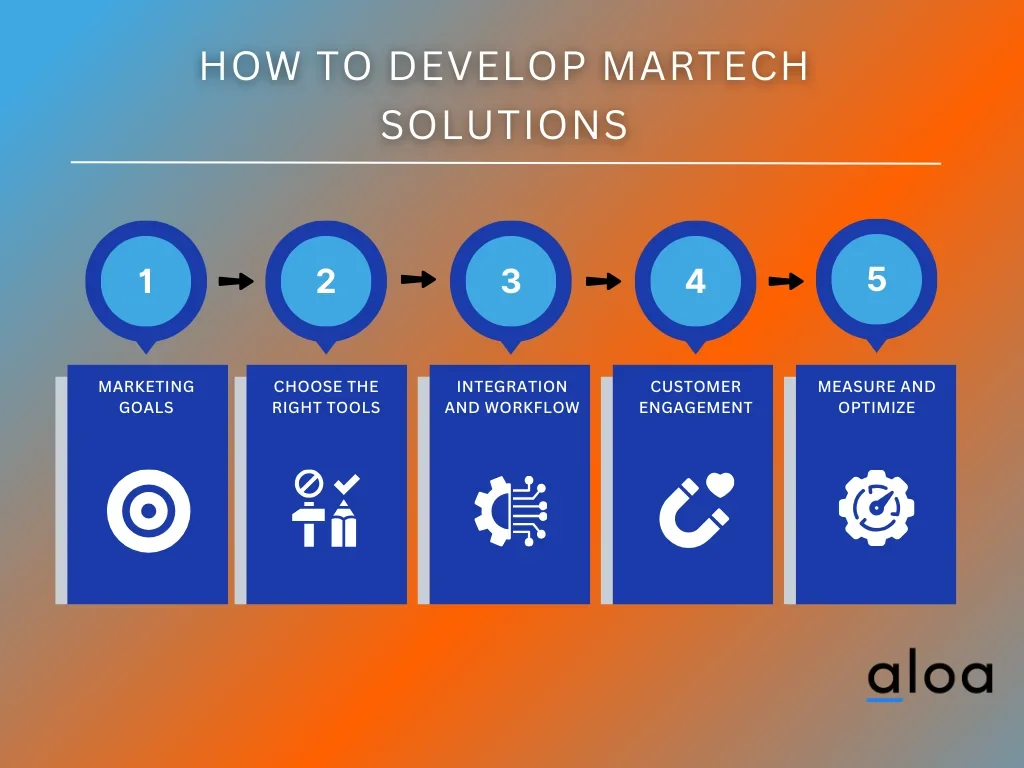
Step 1: Identify Marketing Goals
The foundation of any successful MarTech solution is clearly understanding your marketing goals and objectives. Before you dive into selecting tools and implementing solutions, take the time to define what you want to achieve and how you will measure success. Here's how to get started:
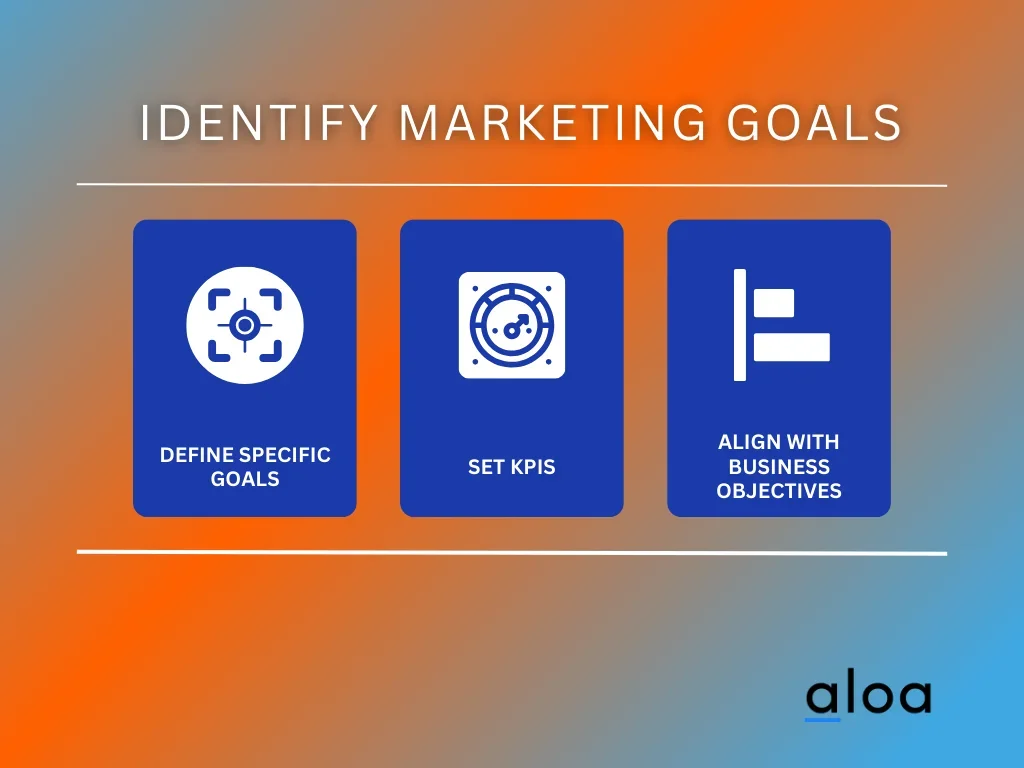
- Define Specific Goals: Clearly define marketing goals, enhancing website traffic, raising conversion rates, or bolstering customer retention.
- Set KPIs: Identify relevant Key Performance Indicators (KPIs) like website traffic, conversion rates, click-through rates, and revenue to measure progress.
- Align with Business Objectives: Ensure your marketing goals align with overall business objectives, contributing to company growth and success.
Defining your marketing goals and KPIs provides a solid framework for selecting and implementing MarTech tools to drive your marketing efforts.
Step 2: Choose the Right Tools
With your marketing goals and KPIs in place, the next step is to research and select the MarTech tools that align with your marketing strategies. The marketplace offers various MarTech solutions, each catering to specific needs and functions. Here's how to make informed tool selections:
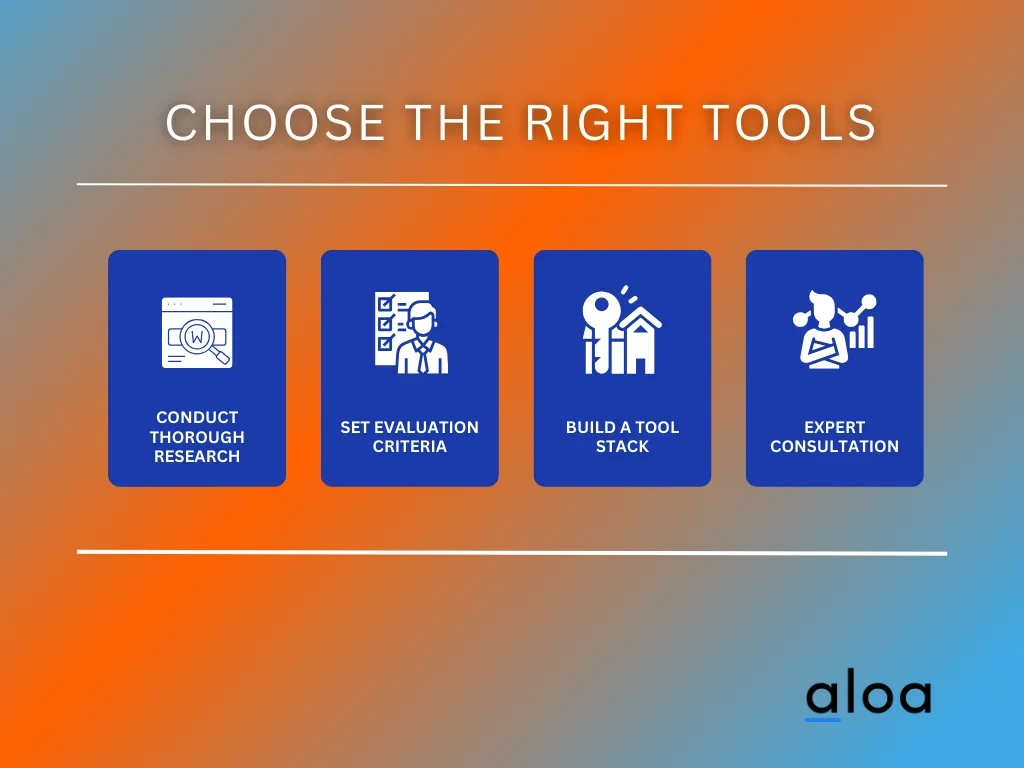
- Conduct Thorough Research: Identify suitable MarTech tools through comprehensive research, considering user reviews, features, pricing, and scalability.
- Set Evaluation Criteria: Establish clear criteria, including ease of use, integration, and compatibility, to assess potential tools.
- Build a Tool Stack: Create a seamless workflow by assembling well-integrated MarTech tools.
- Expert Consultation: Gain insights and recommendations from industry experts or MarTech specialists tailored to your needs.
When choosing MarTech tools, remember that the goal is to have the latest technology and the right technology to support your marketing strategies effectively like if you are focusing on improving your brand recognition you can utilise social media management tools to improve your reach.
Step 3: Integration and Workflow
Once you've selected the appropriate MarTech tools, the next critical step is to ensure seamless integration into your marketing workflows. Siloed data and disconnected systems can hinder the efficiency of your marketing efforts. Here's how to integrate your MarTech solutions effectively:
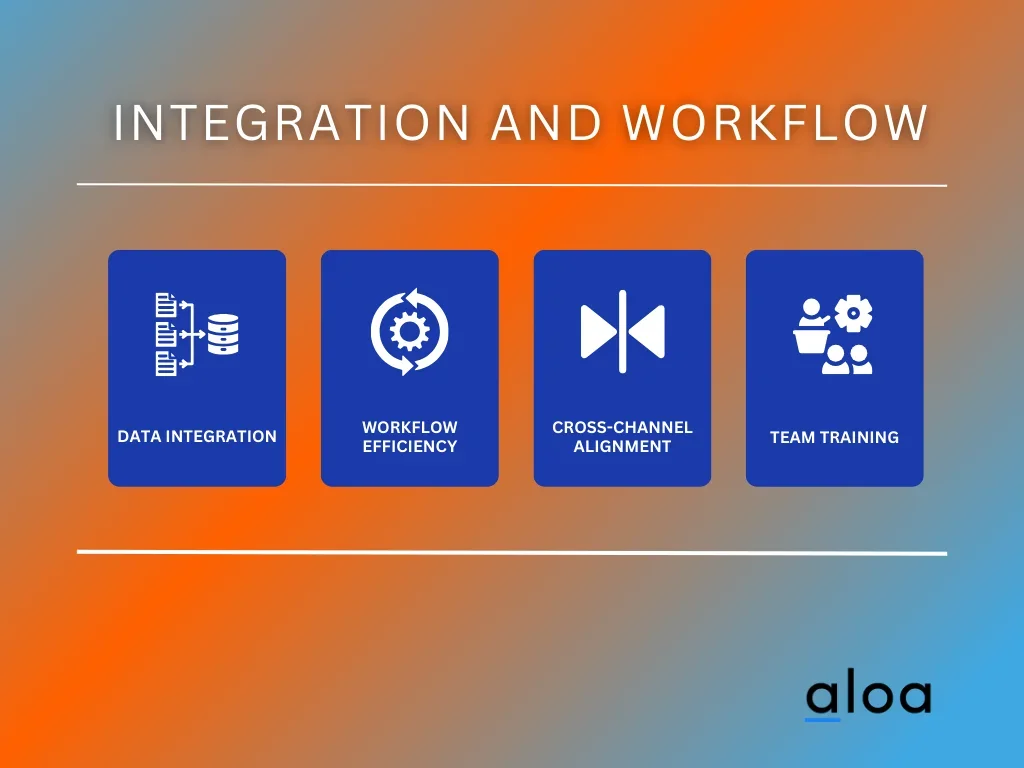
- Data Integration: Seamlessly exchange data between MarTech tools and existing systems like CRM for a comprehensive view of customer interactions.
- Workflow Efficiency: Map and automate marketing workflows to eliminate manual tasks and boost efficiency.
- Cross-Channel Alignment: Ensure MarTech supports cross-channel integration for consistent messaging and customer experiences.
- Team Training: Invest in training for your marketing team to maximize MarTech tool effectiveness and stay updated with new features.
Efficient integration of MarTech solutions into your marketing workflows ensures that data flows seamlessly, processes are streamlined, and your team can work cohesively to achieve your marketing goals.
Step 4: Personalization and Customer Engagement
One of the primary advantages of MarTech solutions is their ability to personalize marketing campaigns based on customer behavior and preferences. Personalization enhances customer engagement and fosters more robust relationships.
Leverage MarTech tools to harness customer data for insights into behavior and preferences. Segment your audience for targeted campaigns. Utilize dynamic content within emails and web pages. Implement marketing automation for personalized messages based on interactions. Conduct A/B testing to refine personalization strategies.
Personalization improves customer engagement and increases the likelihood of conversion and customer loyalty. It shows your audience that you understand their needs and can provide tailored solutions.
Step 5: Measure and Optimize
The final step in developing MarTech solutions is to establish a robust system for measuring the performance of your marketing efforts and making data-driven optimizations. Continuous analysis and refinement are essential for achieving the best results.
Implement analytics tools to track key metrics like website traffic, conversion, click-through, and revenue. Generate regular reports for ongoing evaluation, using Agency Analytics alternative. Analyze data to identify trends and optimization opportunities. Conduct A/B testing for data-driven improvements. Implement iterative optimization processes based on insights gained.
By consistently measuring and optimizing your marketing efforts, you can fine-tune your strategies, improve ROI, and stay responsive to changing market dynamics and customer preferences.
How To Develop AdTech Solutions
Advertising Technology is pivotal in helping businesses reach their target audience effectively and efficiently. AdTech solutions encompass a wide range of tools and strategies, enabling advertisers to create, optimize, and measure the performance of their advertising campaigns across various digital channels.
Let's break down the steps involved in developing AdTech solutions to maximize the impact of your advertising efforts.

Step 1: Understand Ad Campaign Objectives
Before developing an AdTech solution, it's crucial to clearly understand your advertising campaign objectives. Defining your goals will serve as the foundation for the entire process. Here's how to get started:
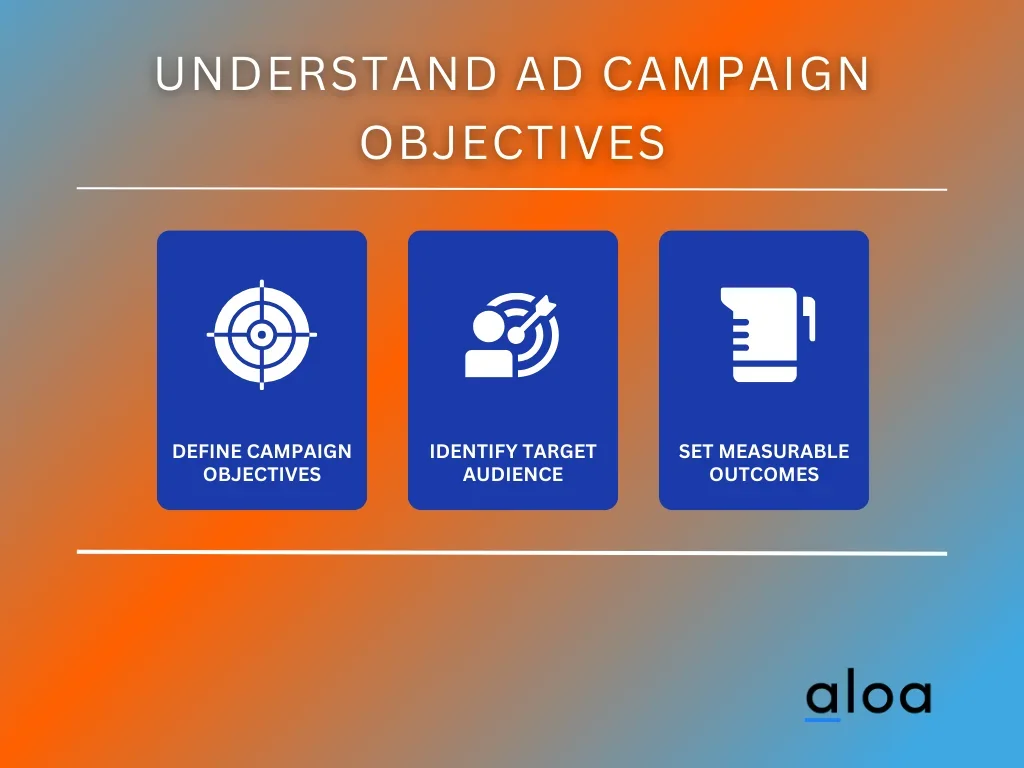
- Define Campaign Objectives: Specify goals like brand awareness, website traffic, leads, or sales for your ad campaigns.
- Identify Target Audience: Know your ideal customer's demographics, interests, and online behaviors.
- Set Measurable Outcomes: Choose KPIs such as ad impressions, clicks, CTR, conversions, and ROAS aligned with your objectives.
A well-defined understanding of your campaign objectives, target audience, and desired outcomes will guide your decisions throughout the AdTech development process.
Step 2: Choose AdTech Tools
With your campaign objectives in mind, it's time to research and select the appropriate AdTech tools that align with your advertising strategies. AdTech encompasses various technologies and platforms designed to facilitate and optimize advertising efforts. Here's how to go about it:
- Research: Investigate AdTech tools considering scalability, ad format diversity, and goal compatibility.
- Programmatic Advertising: Automate ad buying with programmatic platforms for campaign efficiency.
- Ad Exchanges: Optimize ad inventory through suitable exchanges for precise audience targeting.
Selecting the right AdTech tools is critical to the success of your advertising campaigns. Take the time to evaluate your options and choose solutions that align with your campaign objectives and target audience.
Step 3: Content Creation and Distribution
Compelling advertising content is at the heart of any successful ad campaign. Once the AdTech developer has chosen your tools, it's time to create engaging ad content tailored to your target audience:
- Audience-Centric Content: Craft ad content that resonates with your target audience. Tailor your messaging, visuals, and tone to align with the preferences and interests of your ideal customers.
- Utilize AdTech Tools: Leverage AdTech solutions to distribute your ads across relevant ad networks and channels. Ensure that your ads are displayed where your target audience is most likely present.
Effective content creation and distribution are essential for capturing your audience's attention and driving desired actions, whether a click, a conversion, or increased brand engagement.
Step 4: Real-time Optimization
In the dynamic world of digital advertising, real-time optimization is critical to maximizing the impact of your ad campaigns. Implementing real-time bidding and optimization strategies allows you to make data-driven adjustments:
Incorporate real-time bidding (RTB) platforms for immediate ad impression bidding, adjusting bids based on user behavior, ad placement, and competition. Monitor key metrics like CTR, conversion rates, and ROAS to pinpoint underperforming campaigns or channels. Conduct A/B tests to refine ad creatives, headlines, and CTAs based on performance results.
Real-time optimization allows you to adapt to changing market conditions and audience preferences, ensuring your advertising efforts remain effective and efficient.
Step 5: Reporting and Analytics
The final step in developing AdTech software solutions is to harness the power of reporting and analytics to gain insights into the performance of your ad campaigns. How to do it effectively:
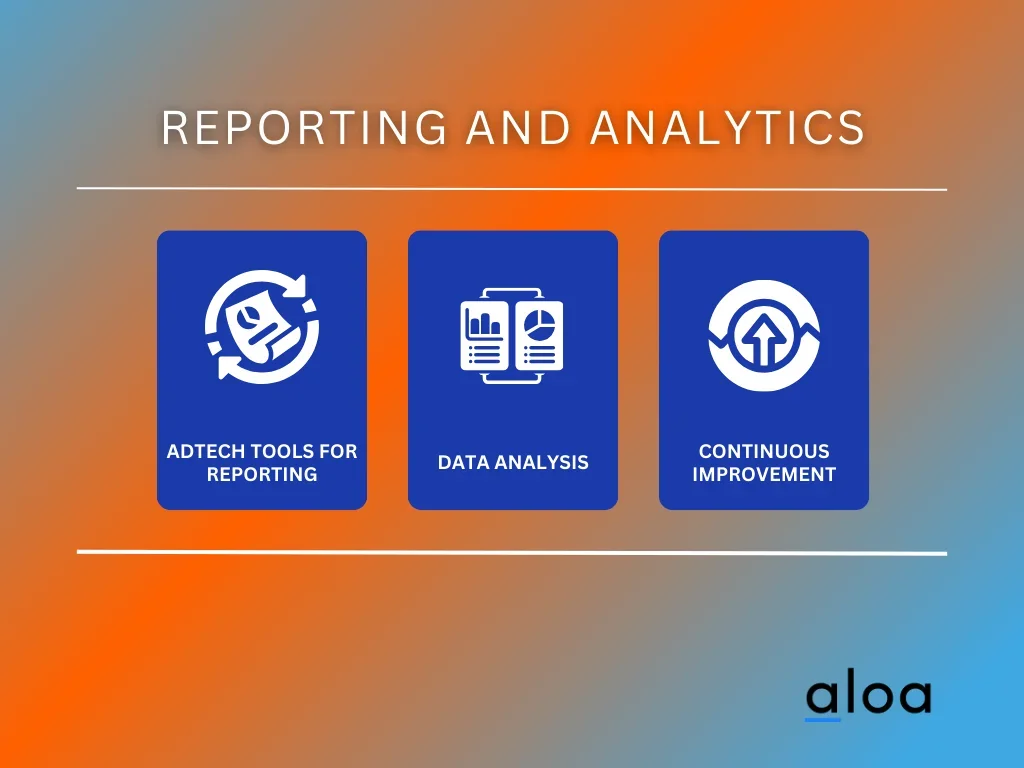
- AdTech Tools for Reporting: AdTech tools offer robust reporting and analytics features. These tools provide detailed data on ad impressions, clicks, conversions, and other relevant metrics.
- Data Analysis: Dive into the data and analyze the performance of your ad campaigns. Identify AdTech trends, patterns, and areas for improvement. Look for insights on which ad channels, placements, or creatives deliver the best results.
- Continuous Improvement: Use the insights from reporting and analytics to make informed decisions for future ad campaigns. Implement changes and optimizations based on the data to enhance the overall effectiveness of your advertising efforts.
Reporting and analytics provide a feedback loop that allows you to refine your advertising strategies over time, ensuring you achieve better results with each campaign.
Examples of MarTech Solutions
MarTech solutions encompass a wide range of tools and platforms that assist in automating marketing processes, providing valuable insights through data analytics, and optimizing user experiences. Among the options available are exemplary solutions, each offering unique features and capabilities.
1. Galactic Fed
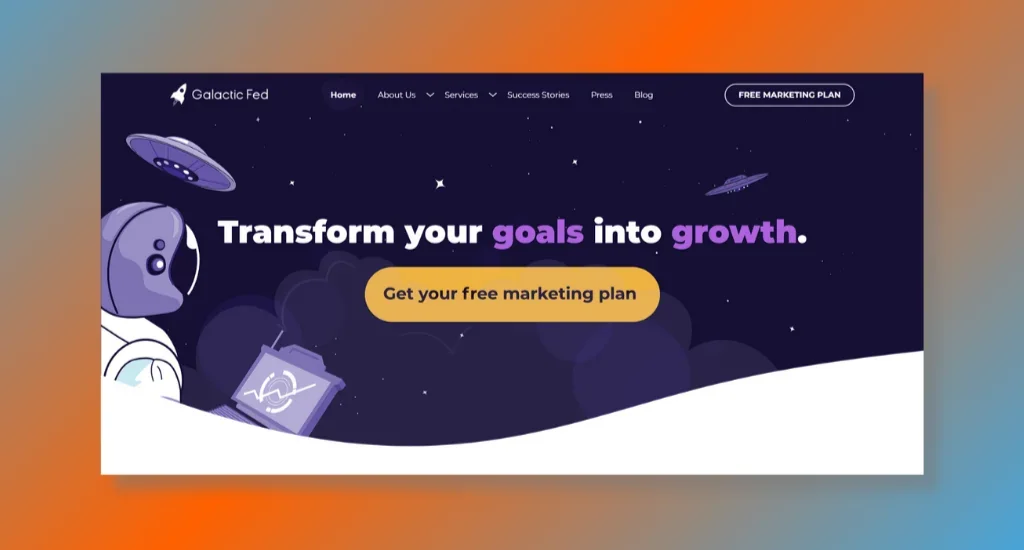
Galactic Fed is a digital marketing agency renowned for its growth hacking and digital marketing expertise. It provides a comprehensive suite of services that covers various aspects of digital marketing, including Search Engine Optimization (SEO), pay-per-click (PPC) advertising, and social media marketing.
Key Features:
- SEO Services: Galactic Fed excels crafting SEO strategies that boost organic traffic and improve search engine rankings. They focus on keyword research, content optimization, and building a robust backlink profile.
- PPC Advertising: The agency specializes in creating targeted ad campaigns on platforms like Google Ads and Facebook Ads, ensuring high ROI through meticulous audience targeting and ad optimization.
- Growth Hacking: They employ innovative growth hacking techniques to rapidly test and scale marketing strategies, driving user acquisition and engagement.
Galactic Fed provides customized strategies that align with specific business goals, leveraging their expertise across various digital channels for a comprehensive marketing approach. They employ data-driven methodologies to effectively track performance and measure Return on Investment (ROI), ensuring their tactics are strategic and results-oriented.
2. Bombora
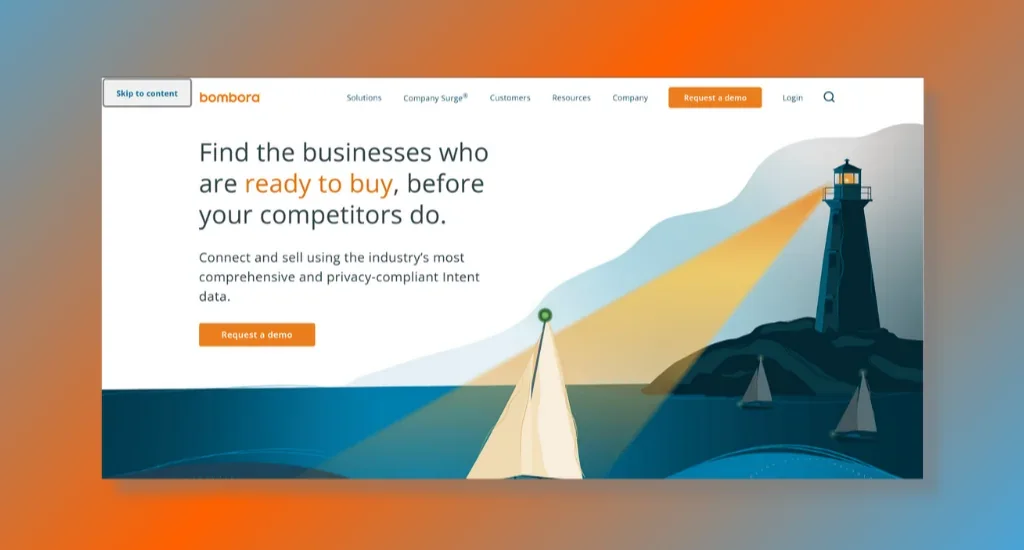
Bombora is a leading provider of intent data for industrial marketing. Their platform leverages big data analytics to help marketers identify and reach companies showing a heightened interest in specific products or services.
Key Features:
- Intent Data Insights: Bombora tracks the content consumption patterns of businesses across the web, providing insights into which companies are actively researching specific topics.
- Account-Based Marketing (ABM): Their data supports ABM strategies by identifying high-potential accounts in the market for specific products.
- Custom Audiences: Marketers can create tailored audience segments for targeted advertising based on the intent data.
Bombora offers significant advantages by enhancing lead generation and qualification, boosting marketing efficiency through targeted spending on interested prospects, and providing valuable insights for tailoring content and messaging to align with the audience's interests.
3. OpenWeb

OpenWeb offers a unique solution focused on fostering healthy online communities and conversations. Their platform is designed to improve the quality of user engagement on websites, mainly for publishers and media companies.
Key Features:
- Community Engagement: OpenWeb provides tools for managing online discussions and encouraging meaningful and civil conversations.
- User Behavior Analytics: The platform analyzes user behavior to provide insights into engagement patterns and preferences.
- Monetization Opportunities: It offers monetization options through improved user engagement and time spent on site.
OpenWeb offers significant benefits by enhancing user experience through improved community engagement. It provides insightful analytics on user behavior and preferences, which can be pivotal for tailoring content and interactions. Additionally, this engagement can increase revenue, as better user retention and engagement often translate into financial gains for the business.
Examples of AdTech Solutions
AdTech encompasses a range of tools and platforms specifically designed to create, manage, and optimize digital advertising campaigns. These AdTech solutions help businesses effectively reach and engage their target audiences. Let's delve into what each of these platforms offers.
1. 33Across
33Across is a technology company specializing in programmatic advertising solutions. It focuses on solving the challenges related to the attention economy in digital advertising.
Key Features:
- AttentionX: 33Across's flagship product, AttentionX, is a programmatic advertising exchange designed to maximize the attention and engagement that ads receive.
- Viewability-Driven Ad Units: The platform provides high-impact ad units optimized for viewability, ensuring users see advertisements.
- Real-Time Data Insights: 33Across offers real-time data analytics, allowing advertisers to optimize their campaigns based on audience engagement and interaction.
33Across offers several key benefits, including improved ad viewability and engagement, access to high-quality programmatic inventory, and valuable data-driven insights that help optimize ad performance and return on investment.
2. Magnite
Magnite is a prominent player in the AdTech landscape, known for its comprehensive sell-side advertising platform. It offers a wide range of tools for publishers to manage and monetize their advertising inventory across various channels.
Key Features:
- Omnichannel Monetization: Magnite supports various formats and channels, including CTV, desktop, mobile, and audio, providing flexibility in ad placement and monetization.
- Advanced Programmatic Capabilities: The platform utilizes advanced programmatic technologies to maximize revenue for publishers while maintaining a high-quality user experience.
- Data-Driven Targeting and Optimization: Magnite's platform leverages data to help publishers optimize their ad inventory and targeting strategies effectively.
Magnite offers significant advantages by maximizing revenue for publishers across multiple channels. It supports various ad formats and targeting options, catering to different advertising needs. Magnite's robust analytics and reporting tools enable effective performance tracking, enhancing overall ad management efficiency.
3. Digital Turbine
Digital Turbine stands out in AdTech by offering unique solutions that integrate advertising with mobile device experiences. It's mainly known for its innovative mobile advertising and app distribution approach.
Key Features:
- On-Device Media Solutions: Digital Turbine delivers ads directly to mobile devices, leveraging unique on-device placements.
- App Distribution: The platform offers app developers and advertisers tools to promote and distribute their apps directly on devices.
- Targeted Advertising: Digital Turbine enables targeted and relevant ad placements by utilizing data and user behavior insights.
Digital Turbine offers significant benefits, including direct access to mobile users through unique placements on devices, efficient app promotion and distribution, and personalized, targeted advertising that enhances user engagement. These features collectively contribute to a more effective and user-centric marketing approach.
Key Takeaway
Staying informed about MarTech vs AdTech is crucial for startups and software developers. In the ever-evolving digital landscape, understanding the nuances of these technologies can make or break your strategies. Startups should embrace both MarTech and AdTech to unlock their full potential. MarTech enhances content management, enabling efficient content marketing, while AdTech maximizes advertising returns.
Recognizing the synergies between MarTech vs AdTech is essential. Breaking down the silos and fostering collaboration between these domains can lead to more efficient campaigns and improved ROI. Continuous learning and exploration are essential to stay at the forefront of the industry. Stay informed about these technologies, and sign up for our email list to access valuable resources. Connect with us at [email protected] to explore the endless possibilities of MarTech and AdTech.

